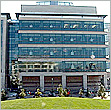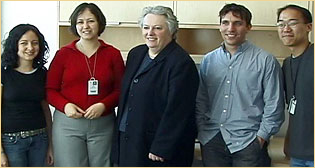
The QB3 headquarters
at UCSF
Mission Bay.
Once relegated to subterranean space on the UCSF Parnassus campus, Sarah Nelson, a professor in the Department of Radiology, now finds herself in the brand-new headquarters of the California Institute for Quantitative Biomedical Research at Mission Bay.
The California Institute for Quantitative Biomedical Research, or QB3, is the third life sciences research building to open at the sprawling 43-acre UCSF Mission Bay campus. Regis B. Kelly, PhD, former executive vice chancellor at UCSF, directs QB3 at its Mission Bay headquarters. He moved into the new building on March 1.
Although scientists and staff have just begun to move into the new building at Mission Bay, QB3 has been operating as a collaborative venture with UC Berkeley and UC Santa Cruz for nearly three years. The California institutes were created under Gov. Gray Davis to fuse public and private sector support for cutting-edge research and training for future scientists, and to help California maintain its leadership in an increasingly competitive technology-based economy.
Nelson will be at the forefront of state-of-the-art technology as she heads the new Margaret Hart Surbeck Laboratory of Advanced Imaging. The laboratory is dedicated to developing high-resolution imaging techniques for basic and translational research, which bridges laboratory findings to benefit patients. Nelson became the first professor on March 2 to move into the QB3 headquarters, a $100 million, 153,000-square-foot building, which is adjacent to UCSF Genentech Hall.
 |
| Sarah Nelson, center, stands with some of the members of her research team, including, from left, Janine Lupo, graduate student, Esin Ozturk, graduate student, Paul DiCamillo, graduate student, and Michael Lee, postdoc. |
Interviewed in her third-floor office overlooking the San Francisco Bay, Nelson said, "I'm delighted to be here. It's been a transition time for me. Eighteen months ago, I was cramped in a very small space underneath the parking structure at the Parnassus campus. There was no window. It was very ugly and there were far too many people sitting on top of each other. And then I moved to the Center for Molecular and Functional Imaging, which was a big improvement because my researchers actually had somewhere where they could sit and they could see daylight.
"But I really feel the challenges here at Mission Bay to bring the more disease-oriented research and engineering techniques that we have together with basic biology is really great. I think it's a new opportunity and I am very excited about it."
Nelson and her 15-person team will be among the first to use the
"7 Tesla" (7T) superconducting magnet - one of the most powerful ever built for magnetic resonance imaging and spectroscopy. The 7T magnet offers a five-fold improvement in imaging sensitivity over those now used clinically, says Nelson, PhD, the Margaret Hart Surbeck Distinguished Professor of Advanced Imaging at UCSF and a professor of bioengineering at UC Berkeley.
These improved images will provide valuable information about the tissue and metabolites in and around cancer and about other disease processes, illuminating the underlying biological mechanisms and helping physicians and researchers monitor response to therapy more effectively.
For Nelson, the move to QB3 represents a new chapter in a long career that has spanned three countries, including a stint as a math teacher in Surrey, England, her homeland. Determined to get involved in cutting-edge science, she earned her PhD at the University of Heidelberg, West Germany, where she first developed techniques for reconstructing and analyzing spectral and imaging data to study patients with brain tumors, prostate cancer and Multiple Sclerosis. She has continued this work at UCSF, and now QB3 offers new opportunities for collaboration with colleagues in varied disciplines.
As a member of the QB3 building committee, Nelson says the driving philosophy for the interior design - as with other research buildings at UCSF Mission Bay -- is based on the desire to foster novel interactions. QB3 offers interaction space and neighborhoods with shared laboratories, where computer scientists, physicists, engineers and biologists can collaborate and communicate.
"The design structure of the building allows for collaboration among laboratories and makes it a better place for science," said Paul DiCamillo, a graduate student in Nelson's lab.
With only a small box containing personal items, such as her cup and tea, and a few pictures for her office, Nelson looked forward to the arrival of their computers, equipment and supplies on her first day at QB3. Once the computers arrive, her team will begin using advanced software algorithms to investigate the differences between normal and abnormal tissues, using data from other whole-body MR scanners elsewhere at UCSF. The 7T and its more widely used 3T magnet will be up and running on the first floor of QB3 by mid-April.
Over the next few weeks, 14 more researchers will move into QB3, which eventually will bring together 28 principal investigators and their staff. UCSF is currently recruiting for several faculty positions in cellular/molecular engineering, imaging, complex systems and bioinformatics. For more information on the UCSF QB3 recruitment, go
online.
Source: Lisa Cisneros
Video Editing: Julie Bernstein
Related Links
UCSF Mission Bay website
QB3 website
Sarah Nelson laboratory website


